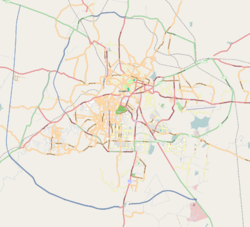- Malleswaram
-
— neighbourhood — Coordinates 12°58′48″N 77°34′30″E / 12.98°N 77.575°ECoordinates: 12°58′48″N 77°34′30″E / 12.98°N 77.575°E Time zone IST (UTC+05:30) Malleswaram (Kannada: ಮಲ್ಲೇಶ್ವರಂ) or Malleshwara, located in the north-west of Bangalore, derives its name from the famous Kaadu Malleswara temple. Originally a village named Mallapura, Malleswaram was developed as a suburb during the great plague of 1898, which caused many people to move out from the city center. Sri Venkatranga Iyengar is credited with the founding of Malleshwaram. He loved riding and one day visited and liked the Malleswara temple. He envisioned a locality of noblemen who would lead a rich and cultured life around the temple. He made his vision a reality as he was connected to the Bangalore Municipality.[1] Malleswaram, together with Basavangudi, represents one of the oldest residential localities of Bangalore, and was planned by the then Dewan of Mysore Kingdom, Sir K. Seshadri Iyer.
Malleswaram is one of the areas in Bangalore where you can find many Hindu Temples. Also, Malleswaram is a hotspot of educational activities with many schools and colleges spread all across the area. Malleswaram is also adjacent to one of the oldest localities Palace Guttahalli.
Contents
Cultural landmarks
The Chowdiah Memorial Hall, named after the violin maestro Tirumakudalu Chowdiah, is one of the most prominent landmarks of Malleswaram. Designed in the shape of a violin, the venue is a hub of arts and culture, playing host to a wide array of events - ranging from classical music concerts, to theatre and drama, to prestigious quiz competitions.
Culture
Due to a large presence of temples, many of which were well established for more than 400 years, Malleswaram is home to a large orthodox Hindu population. Electorally, Malleswaram is largely regarded as a hub for Brahmins , a community which forms a sizeable and influential majority in this ward.[2]
The neighborhood of Malleswaram hosts traditional people, spiritual people, ordinary people, and extraordinary people. Nobel laureates (C.V. Raman), and world champions (Prakash Padukone) live or lived here, so did many writers, scholars, musicians (Doraiswamy Iyengar), and educationists (M.P.L.Shastry). The ward is characterised by mixed demographics, sustaining a substantial middle class, upper middle class and elite residential areas. The flowering trees on either sides of the streets hide all the pollution, and the popular street-side eateries obscure some of the finest south Indian restaurants in the city.
Malleswaram can be called one of the prominent cultural hubs in Bangalore. There are many prominent dancers, musicians and gurus here. In every street you can find serious art/dance/music students. You can find many Bharatanatyam, Kathak, Kuchipudi and folk dance schools here.Classical Carnatic, Hindustani and light music schools are also aplenty.
Seva Sadana (near MLA College, Shirdi Sai Baba Mandir) and Mahati Cultural Academy (MCA) near (Halli Mane Hotel) hosts many cultural events. Some of the wonderful programs that one can catch here are the Ananya Nritya Dhare, Sai Nrityotsava, Classical music events, Lecture demonstrations etc. The MES kalavedi also hosts many cultural events. During the festive seasons, many artists perform at the Kannika Parameshwari temple and the Venugopalaswamy temple. Recently, Bangalore City Corporation has renamed the area as Kadu Malleshwara from Malleshwaram.
Temples
Malleswaram has old Hindu Temples constructed using the Dravidian architecture which were built during King Venkojirao Bhonsle of Thanjavur's time (17th century C. E.) like the Kadu Malleshwara temple, which is well attended during the holy day of Shivaratri. At the Nandi Teertha temple, one can see water fall onto an idol of Shiva through the mouth of Nandi. The Lakshmi Narasimha Temple is also very famous. The Venugopal Temple is over more than 100 years old. The Sri Krishna temple, opposite railway station, is over 72 years old. The Circle Maramma Temple at 18th cross is very famous. New vehicles queue up for pooja every Friday. Kanchi Mutt, Kashi Mutt, Chitrapur Mutt and Palimar Mutt are also located in Malleswaram. Malleswaram also has monasteries and trees which are more than 80 years old. Kannika Parameshwari Temple on 8th cross was built by the Arya Vysya community in Malleswaram.
Transport
Malleswaram is well connected by the Bangalore Metropolitan Transportation Corporation buses (BMTC) with the downtown and other localities in Bangalore. Sampige Road and Margosa Road are the two main roads running through the heart of Malleswaram. The vehicular density and the resulting pollution on these roads is a major cause of concern. Construction of the Malleswaram Underpass has alleviated some of the traffic problems. However, since a majority of the commuters to Malleswara are from other areas of Bengaluru, inauguration of the Bangalore Metro could help in stabilizing the vehicular population of Malleswaram. Experts suggest that the archaic and severely under-utilized Malleswaram Railway Station can alleviate the traffic problems of Malleswaram to a large extent, if it is developed into a Metro station.[citation needed]
References
- ^ "HISTORY". http://www.malleswaram.com/index.php/about/history. Retrieved 2011-05-04.
- ^ "Culture". http://www.malleswaram.com/index.php/about/culture. Retrieved 2011-05-04.
External links
Categories:- Neighbourhoods of Bangalore
Wikimedia Foundation. 2010.



